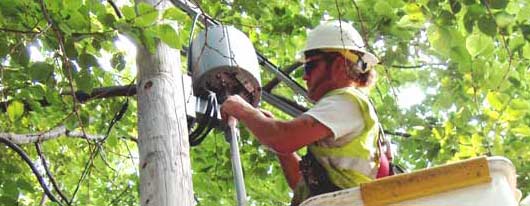
Worker adjusting the wireless access point outside my window.
Featured Tag: Wireless
Main Tags
art
blogging
learning
mac
movies
other
politics
science
tech
wireless
Tuesday, March 17, 2009
Can Computers Take Advantage of Ultra-High-Speed Bandwidth?
Christopher Mitchell is Research Associate over at the Institute for Local Self-Reliance, an organization that (among other things) supports democratic access to airwaves and wires. I've asked Christopher to post on broadband issues. I hope this won't be the last you see of him here. You can reach Christopher at christopher@newrules.org.
Can Computers Take Advantage of Ultra-High-Speed Bandwidth?
Christopher Mitchell
During discussions about the need for ultra-high-speed bandwidth in communities around Minnesota, some have suggested that many people have computers that cannot take advantage of these faster connections. This has happened before the Governor’s Task Force as well as Committees in the Legislature. One person even suggested that some computers cannot take advantage of speeds beyond 5 megabits/second.
This claim is not only inaccurate; it reveals a flawed understanding of how Internet connections are used in the modern household.
Modern families frequently have multiple devices competing for bandwidth and sharing a single connection, including hand-held Wi-Fi devices, multiple computers and gaming machines and — starting this year — televisions and TiVos downloading content directly from the Internet.
To illustrate: Mom may be checking into the office remotely via VPN, Dad may be uploading video from yesterday's little league baseball game, Suzy is watching a lecture from Stanford for college credit, Tom is on a vidchat with friends, and grandma is checking in with her doctor.
A home office user may sometimes need very fast speeds to transfer large files to co-workers or to rapidly backup large amounts of data. Vendors could provide Ultra-High-Speed networks with bandwidth on demand allowing a user to purchase a 50Mbps connection during the hours from 8-noon and have a more modest connection otherwise.
Fast Internet connections will not be forced upon those who have no use for them. However, communities increasingly have businesses and power users demanding faster connections at affordable prices.
Thus, the argument that communities do not need these connections because some have computers unable to use them is at best irrelevant. But it is also inaccurate.
Ten years ago, computer motherboards had a standard Ethernet jack providing at least 10Mbps speeds. Thus, if someone is using a computer that was purchased within the last 10 years, we can be confident that the computer, at a minimum, can handle a 10Mbps connection. If it cannot, a $20 network card will solve that problem.
The 10/100 network cards (which connect to networks running both at 10Mbps and 100Mbps) were available ten years ago but did not become a standard on most PCs until around 2002-3. Nine years ago, the iMac offered a standard 10/100 port, meaning that any Mac purchased within the previous nine years will almost definitely support 100Mbps speeds.
If I had to guess, I would suspect that at least 95% of computers used today have been purchased within the previous ten years. Nearly all of those computers will have a 10/100 network port built in, allowing them to take advantage of up to 100Mbps. But even faster network speeds have long been available — the University of Minnesota has connected devices to its network at 1000Mbps (1 Gigabit/second) since 2004.
A few months ago, I purchased a refurbished laptop from Dell. For $1000, I received a laptop that came with 1Gbps networking capabilities.
Though most computers today may not have the ultra-high-speed capability of my laptop, we must keep in mind that it will take several years — under the most optimistic schedule imaginable — before these speeds are available to homes. By that time, computers will have commonly supported 100Mbps or faster speeds for many years.
What we call ultra-high-speed networks are becoming commonplace in parts of Europe and Asia. Our computers are not the limiting factor, the high cost and limited returns of building these faster networks is the issue.
Christopher Mitchell is the Director of the Telecommunications as Commons Initiative at the Institute for Local Self-Reliance in Minneapolis. His e-mail address is christopher@ilsr.org

